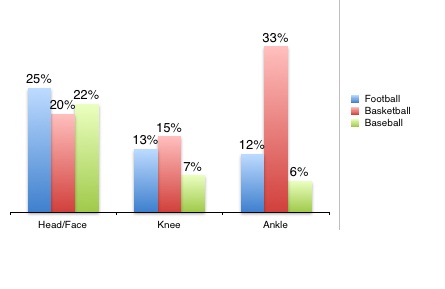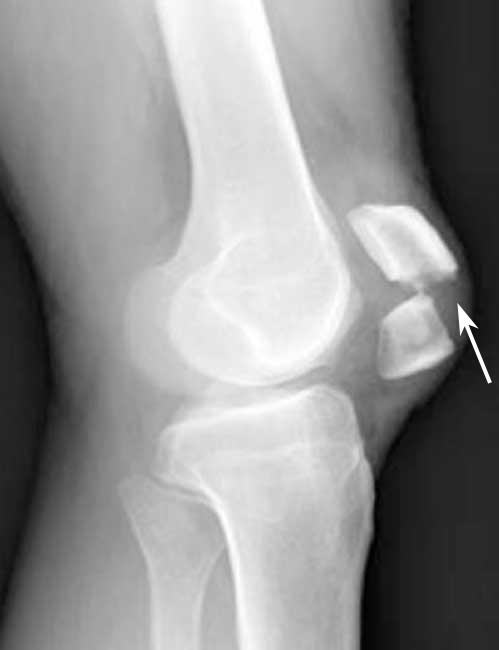Injuries is another barrier that prevents participation in sports, these injuries can be long term or short-term effects, many sports injuries can be prevented if people take the proper precautions (Robert R. Salerno; 2009) up to 30% to 40% of all accidents in children and adolescents occur during sports (Smith AD, Tao SS 1995) children have a lower percentage than adolescents (Klenerman L. 1994) boys may sustain twice as many injuries as girls (Zaricznyj B et al;1980), this can happen due to poor training practices, improper equipment, lack of conditioning, or insufficient warm-up and stretching.

Depending on the persons mental health they might want to come out of injury with a positive approach as the Self-determination theory has been proposed as being important for Return To Play after a serious injury (Podlog L, Eklund RC; 2010) psychological factors like motivation, confidence and low fear, means they will come back stronger mentally and physically (Ardern CL, Taylor NF, Feller JA et al;2013) in other cases the participant might want to quit sports or physical activities in general due to the experience they’ve been through, there’s studies regarding children dropping out of sport (Caine DJ, Maffulli N; 2005) due to injuries with different types of injuries will also determine how they will cope mentally and physically.
Previous studies examined the differences in injury patterns between team and individual sport athletes from 12–19 years of age who participated in a variety of school sports, this study found that team sport athletes were at higher risk for injury in general when compared to individual sport athletes (Theisen D, et al 2013).

For example, knee injuries related to meniscus or ACL surgery during adolescence or childhood will reduce the chances of future involvement in physical activity leading to less-than-optimal health in later life sports injuries also affect both growing bone and soft tissues and could result in damage of the growth mechanisms with subsequent life-lasting damage (Maffulli, N., Bruns, W;2000), studies provide evidence that in individuals who sustain a knee injury (meniscal or ACL) 50% will have knee osteoarthritis 12 to 20 years later compared to the uninjured population.

Strategies to prevent injuries:
Coaches and parents can help minimize the risk of injury by ensuring the proper selection of sporting events, using appropriate equipment, enforcing rules, using safe playing conditions, and providing adequate supervision (Quedenfeld T 1993). Although injuries in young athletes sustain negative effects of sports injuries with the many social, psychological and serious commitments to sport brings so it’s important to help them balance their lifestyle with sport by allowing them to take breaks from sport.

There are also injury prevention programs that can also help reduce risks of injuries so that growing athletes can adjust to their own body changes, this is based on training content, duration and frequency, as well as athlete compliance (Frisch A et al; 2009) .
Goal setting (Evans L, Hardy L; 2002)can help motivate the person to take part in sport again, couseling (Rock JA, Jones MV; 2002) helps athletes to cope with negative feelings and positive self (Scherzer CB et al 2001) promotes positive mood by reducing fear and anxiety.
References:
Ardern CL, Taylor NF, Feller JA, et al. A systematic review of the psychological factors associated with returning to sport following injury. Br J Sports Med. 2013 Nov;47(17):1120–1126.
Caine DJ, Maffulli N. Epidemiology of children’s individual sports injuries. An important area of medicine and sport science research. Med Sport Sci. 2005;48:1–7.
de Vos RJ, van Veldhoven PL, Moen MH, Weir A, Tol JL, Maffulli N (2010). Autologous growth factor injections in chronic tendinopathy: a systematic review. Br Med Bull.
Evans L, Hardy L. Injury rehabilitation: a goal-setting intervention study. Res Q Exerc Sport. 2002 Sep;73(3):310–319.
Frisch A, Croisier JL, Urhausen A, Seil R, Th eisen D (2009). Injuries, risk factors and prevention initiatives in youth sport. Br Med Bull;92: 95–121.
Klenerman L. ABC of sports medicine (1994). Musculoskeletal injuries in child athletes. BMJ;308(6943):1556–1559.
Maffulli, N., Bruns, W. Injuries in young athletes. Eur J Pediatr 159,59–63 (2000)
Quedenfeld T (1993). Sports-related injuries in youth: prevention is the key—and nurses can help! Pediatr Nurs;19(4):333–342
Podlog L, Eklund RC. Returning to competition after a serious injury: the role of self-determination. J Sports Sci. 2010 June;28(8):819–831.
Rock JA, Jones MV. A preliminary investigation into the use of counseling skills in support of rehabilitation from sport injury. J Sport Rehabil. 2002;11(4):284–304.
Robert R. Salerno (2009), Sports Injuries and its Effects on Health.
Scherzer CB, Brewer BW, Cornelius AE, et al. Psychological skills and adherence to rehabilitation after reconstruction of the anterior cruciate ligament. J Sport Rehabil. 2001;10(3):165–172.
Smith AD, Tao SS (1995). Knee injuries in young athletes. Clin Sports Med;14(3):629–650. 4.
Theisen D, Frisch A, Malisoux L, et al. Injury risk is different in team and individual youth sport. J Sci Med Sport. 2013;16(3):200–204.
Zaricznyj B, Shattuck LJM, Mast TA, Robertson RV, D’Elia G (1980) Sports-related injuries in school aged children. Am J Sports Med 8:3318-3324
